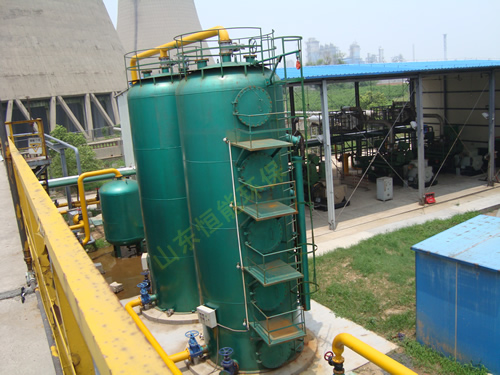歡迎進(jìn)入山東恒能環(huán)保能源設(shè)備有限公司
歡迎進(jìn)入山東恒能環(huán)保能源設(shè)備有限公司
沼氣脫硫的原理主要基于三種常見(jiàn)方法:干法脫硫、濕法脫硫和生物脫硫,以下是具體原理介紹:
The principle of biogas desulfurization is mainly based on three common methods: dry desulfurization, wet desulfurization, and biological desulfurization. The following is a specific principle introduction:
1. 干法脫硫原理
1. Principle of dry desulfurization
核心反應(yīng):利用氧化鐵(Fe?O?)等脫硫劑與硫化氫(H?S)發(fā)生化學(xué)反應(yīng),將H?S氧化為單質(zhì)硫或硫氧化物,從而去除沼氣中的硫化氫。
Core reaction: Using desulfurizers such as iron oxide (Fe ? O ∝) to chemically react with hydrogen sulfide (H ? S), H ? S is oxidized to elemental sulfur or sulfur oxides, thereby removing hydrogen sulfide from biogas.
反應(yīng)方程式:
Reaction equation:
Fe?O?·3H?O + 3H?S → Fe?S? + 6H?O
Fe?O?·3H?O + 3H?S → Fe?S? + 6H?O
Fe?S? + 3/2O? + 3H?O → Fe?O?·3H?O + 3S
Fe?S? + 3/2O? + 3H?O → Fe?O?·3H?O + 3S
工作過(guò)程:含H?S的沼氣通過(guò)裝有脫硫劑的容器,H?S與脫硫劑接觸反應(yīng),生成的硫或硫氧化物留在脫硫劑中,凈化后的沼氣排出。當(dāng)脫硫劑吸附飽和后,可通過(guò)自然通風(fēng)或添加空氣使其與氧氣接觸,發(fā)生氧化反應(yīng)再生,恢復(fù)脫硫能力。
Working process: Biogas containing H ? S passes through a container containing a desulfurizer, and H ? S reacts with the desulfurizer to produce sulfur or sulfur oxides that remain in the desulfurizer. The purified biogas is discharged. When the desulfurizer is saturated with adsorption, it can be exposed to oxygen through natural ventilation or the addition of air to undergo oxidation reaction regeneration and restore desulfurization capacity.
2. 濕法脫硫原理
2. Principle of wet desulfurization
核心反應(yīng):以堿性溶液(如碳酸鈉Na?CO?、氫氧化鈉NaOH等)為吸收劑,吸收H?S后,在催化劑作用下將H?S氧化為單質(zhì)硫。
Core reaction: Using alkaline solutions (such as sodium carbonate Na ? CO ∝, sodium hydroxide NaOH, etc.) as absorbents, after absorbing H ? S, H ? S is oxidized to elemental sulfur under the action of a catalyst.
反應(yīng)方程式:
Reaction equation:
H?S + Na?CO? → NaHS + NaHCO?
H?S + Na?CO? → NaHS + NaHCO?
2NaHS + O? → 2S↓ + 2NaOH
2NaHS + O? → 2S↓ + 2NaOH
工作過(guò)程:沼氣與堿性溶液逆流接觸,H?S被吸收形成硫氫化物(NaHS),再通過(guò)氧化反應(yīng)生成單質(zhì)硫沉淀。吸收后的堿液進(jìn)入再生塔,經(jīng)空氣氧化和催化劑作用,使硫氫化物轉(zhuǎn)化為單質(zhì)硫分離出來(lái),堿液再生后循環(huán)使用。
Working process: Biogas comes into countercurrent contact with alkaline solution, and H ? S is absorbed to form hydrosulfide (NaHS), which is then oxidized to form elemental sulfur precipitate. The absorbed alkaline solution enters the regeneration tower, where it is oxidized by air and catalyzed to convert sulfur hydride into elemental sulfur, which is separated. The alkaline solution is then recycled after regeneration.
3. 生物脫硫原理
3. Principle of biological desulfurization
核心反應(yīng):利用特定的嗜硫細(xì)菌(如氧化亞鐵硫桿菌等),將H?S氧化為單質(zhì)硫或硫酸鹽。
Core reaction: Using specific sulfur loving bacteria (such as Thiobacillus ferrooxidans) to oxidize H ? S into elemental sulfur or sulfate.
反應(yīng)方程式:
Reaction equation:
H?S + 2O? → H?SO?
H?S + 2O? → H?SO?
H?S + O? → 2S + 2H?O
H?S + O? → 2S + 2H?O
工作過(guò)程:沼氣與含營(yíng)養(yǎng)液的生物反應(yīng)器接觸,嗜硫細(xì)菌吸收H?S并將其氧化為單質(zhì)硫或硫酸鹽。單質(zhì)硫可作為副產(chǎn)品回收,硫酸鹽則通過(guò)后續(xù)處理去除。生物脫硫系統(tǒng)需維持適宜的溫度、pH值和營(yíng)養(yǎng)條件,以保證細(xì)菌的活性和脫硫效率。
Working process: Biogas comes into contact with a bioreactor containing nutrient solution, and sulfur loving bacteria absorb H ? S and oxidize it into elemental sulfur or sulfate. Elemental sulfur can be recovered as a byproduct, while sulfate is removed through subsequent processing. The biological desulfurization system needs to maintain appropriate temperature, pH value, and nutritional conditions to ensure bacterial activity and desulfurization efficiency.
總結(jié):干法脫硫適用于小氣量、低濃度H?S場(chǎng)景,成本低但需定期更換脫硫劑;濕法脫硫適用于大氣量、高濃度H?S,脫硫效率高且可連續(xù)運(yùn)行;生物脫硫則具有高效、低成本、環(huán)保等優(yōu)勢(shì),但對(duì)運(yùn)行條件要求較高。實(shí)際應(yīng)用中,常根據(jù)沼氣的氣量、H?S濃度和使用需求選擇合適的方法,或采用組合工藝(如濕法粗脫硫+干法精脫硫)以達(dá)到更好的脫硫效果。
Summary: Dry desulfurization is suitable for small gas volume and low concentration H ? S scenarios, with low cost but requiring regular replacement of desulfurizers; Wet desulfurization is suitable for large gas volumes and high concentrations of H ? S, with high desulfurization efficiency and continuous operation; Biological desulfurization has advantages such as high efficiency, low cost, and environmental protection, but it requires high operating conditions. In practical applications, appropriate methods are often selected based on the gas volume, H ? S concentration, and usage requirements of biogas, or a combination process (such as wet coarse desulfurization+dry fine desulfurization) is adopted to achieve better desulfurization effects.
本文由 沼氣脫硫 友情奉獻(xiàn).更多有關(guān)的知識(shí)請(qǐng)點(diǎn)擊 http://www.bst316.com/ 真誠(chéng)的態(tài)度.為您提供為全面的服務(wù).更多有關(guān)的知識(shí)我們將會(huì)陸續(xù)向大家奉獻(xiàn).敬請(qǐng)期待.
This article is contributed by the friendship of biogas desulfurization For more related knowledge, please click http://www.bst316.com/ Sincere attitude To provide you with comprehensive services We will gradually contribute more relevant knowledge to everyone Coming soon.
相關(guān)新聞